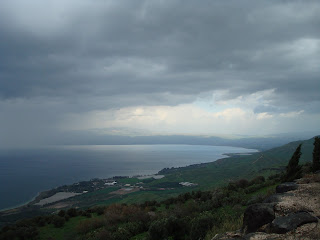Desert Embroidery:
They are incredibly impressive, and just the group of passionate people that I have been looking for. Their work is incredibly brave, striving to navigate an elegant middle road between deeply rooted traditions and societal progress – traditional values and women’s rights. Their embroidery challenges gender stereotypes, builds community literacy, empowers women, and creates connections with Jewish communities.
They welcomed us with a wonderful cup of tea, and began to explain their work as we gathered in a round circle. They empower women and girls through literacy, building a stronger community and trying to make peace with neighboring communities. The parallels with Greg Mortenson's "Three Cups of Tea" were quite remarkable. There are continuing conflicts between Jewish and Bedouin communities, communities marginilized much like native Americans in the U.S. Their drive to improve their lot, contribute to Israeli culture, and maintain a positive ecological imprint is simply unbelievable. Literacy works wonders.
http://desert-embroidery.org/
Reflection from the banks of the Sea of Galilee:
“I felt my feet were praying.”
– Abraham Joshua Heschel (on marching with MLK)
I accidentally encountered a deep puddle during a late night walk along the shores of the Sea of Galilee. My feet are soaking wet as I journal from a lifeguard tower. The light breeze occasionally knocks drops of rainwater from the bamboo-mat roof, so I open and close my computer to keep it safe and dry.
I hear frogs. I hear crashing waves. I hear beetles (I think they are beetles…). I hear a stray cat. I hear wind blow and raindrops patter. A raindrop falls on my screen, and I wipe it gently away.
I could hike the perimeter of the sea in a matter of days, the sea so integrally connected to all I’ve learned here. It feeds Israel’s agriculture, but the diversion of its outflow shrinks the Dead Sea. The Kinneret is at the heart of Israel’s vitality, yet also at the core of regional geopolitical dilemmas.
There is a shiny fireman’s pole at the front of this tower. What better way to quickly escape back into the warm indoors? I look forward to hitting spongy ground below. When my wet shoes smack down on the soil below
Pictures:
Captions are below each. I really like these pictures; each one says a great deal.

Atop an extinct volcano, the peak of which pierced the clouds. Or perhaps Jurassic park. These marvelous sculptures truly came alive amongst the stunning volcanic rock. I wish I could go back and do a better job taking this picture!

The Jordan River, Yarden, where John the Baptist baptized Jesus. Stairs allow pilgrims to submerge in the holy waters. This part of the Yarden is actually not the river’s trunk, but a diverted portion, with a dam visible in the background. These diversions are a serious problem, but an agricultural necessity. As the rivers shrinks, so do Lake Kinneret (the Sea of Galilee) and the Dead Sea. This picture appears simple, but is truly stunning. We see a holy site, a modern pilgrimage site, and a dam that connects religion and history to contemporary struggles.

From the Golan Heights: the Sea of Galilee on a stormy afternoon. Notice the agriculture on the fertile banks.

Two Bedouin woman create woven products.

Shalom, our wonderful tour-guide at the Golan Heights Winery, looks out lovingly at the sea of oak barrels filled with aging wines. We went to an amazing wine tasting afterwards. For the sake of grant funding, let’s call it “field research in local agriculture and industry”.

Shabi, a biology student at Oranim college, approaches a pond. A poem is in the foreground. The poetry on this path in the botanical garden was collaboration with the literature department.

Our Druze guide demonstrates how to use a traditional coffee grinder. He met us in Osafiya, and explained that grinding coffee outside of one’s home is a sign of hospitality and welcoming.



No comments:
Post a Comment